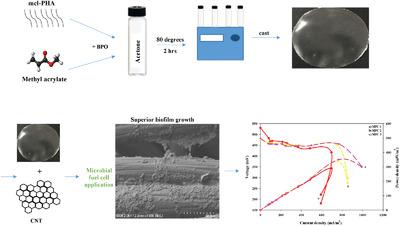当前位置:
X-MOL 学术
›
Biotechnol. Appl. Bioc.
›
论文详情
Our official English website, www.x-mol.net, welcomes your
feedback! (Note: you will need to create a separate account there.)
Composite of medium‐chain‐length polyhydroxyalkanoates‐co‐methyl acrylate and carbon nanotubes as innovative electrodes modifier in microbial fuel cell
Biotechnology and Applied Biochemistry ( IF 3.2 ) Pub Date : 2020-04-21 , DOI: 10.1002/bab.1928 Abdul Azeez Olayiwola Sirajudeen 1 , Mohamad Suffian Mohamad Annuar 1 , Ramesh Subramaniam 2
Biotechnology and Applied Biochemistry ( IF 3.2 ) Pub Date : 2020-04-21 , DOI: 10.1002/bab.1928 Abdul Azeez Olayiwola Sirajudeen 1 , Mohamad Suffian Mohamad Annuar 1 , Ramesh Subramaniam 2
Affiliation

|
A microbial fuel cell is a sustainable and environmental‐friendly device that combines electricity generation and wastewater treatment through metabolic activities of microorganisms. However, low power output from inadequate electron transfer to the anode electrode hampers its practical implementation. Nanocomposites of oxidized carbon nanotubes and medium‐chain‐length polyhydroxyalkanoates (mcl‐PHA) grafted with methyl acrylate monomers enhance the electrochemical function of electrodes in microbial fuel cell. Extensive polymerization of methyl acrylate monomers within mcl‐PHA matrix, and homogenous dispersion of carbon nanotubes within the graft matrix are responsible for the enhancement. Modified electrodes exhibit high conductivities, better redox peak and reduction of cell internal resistance up to 76%. A stable voltage output at almost 700 mV running for 225 H generates maximum power and current density of 351 mW/m2 and 765 mA/m2, respectively. Superior biofilm growth on modified surface is responsible for improved electron transfer to the anode hence stable and elevated power output generation.
中文翻译:

中链长度的聚羟基链烷酸酯-丙烯酸甲酯和碳纳米管的复合物,作为微生物燃料电池中的新型电极改性剂
微生物燃料电池是一种可持续且环保的设备,通过微生物的代谢活动将发电和废水处理相结合。然而,由于不充分的电子转移到阳极电极而产生的低功率输出妨碍了其实际实施。氧化碳纳米管和丙烯酸甲酯单体接枝的中链长度聚羟基链烷酸酯(mcl-PHA)的纳米复合材料增强了微生物燃料电池中电极的电化学功能。丙烯酸甲酯单体在mcl-PHA基质中的广泛聚合以及碳纳米管在接枝基质中的均匀分散是增强作用的原因。改性电极表现出高电导率,更好的氧化还原峰和电池内阻降低高达76%。分别为2和765 mA / m 2。改性表面上优异的生物膜生长有助于改善电子向阳极的转移,从而稳定和提高发电量。
更新日期:2020-04-21
中文翻译:

中链长度的聚羟基链烷酸酯-丙烯酸甲酯和碳纳米管的复合物,作为微生物燃料电池中的新型电极改性剂
微生物燃料电池是一种可持续且环保的设备,通过微生物的代谢活动将发电和废水处理相结合。然而,由于不充分的电子转移到阳极电极而产生的低功率输出妨碍了其实际实施。氧化碳纳米管和丙烯酸甲酯单体接枝的中链长度聚羟基链烷酸酯(mcl-PHA)的纳米复合材料增强了微生物燃料电池中电极的电化学功能。丙烯酸甲酯单体在mcl-PHA基质中的广泛聚合以及碳纳米管在接枝基质中的均匀分散是增强作用的原因。改性电极表现出高电导率,更好的氧化还原峰和电池内阻降低高达76%。分别为2和765 mA / m 2。改性表面上优异的生物膜生长有助于改善电子向阳极的转移,从而稳定和提高发电量。










































 京公网安备 11010802027423号
京公网安备 11010802027423号